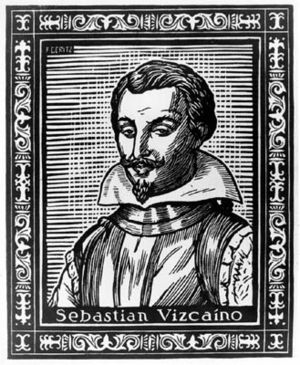Sebastián Vizcaíno facts for kids
Quick facts for kids
Sebastián Vizcaíno
|
|
|---|---|
 |
|
| Born | ca. 1548 |
| Died | 1624 (aged 75–76) |
| Nationality | Spanish |
Sebastián Vizcaíno (born around 1548, died 1624) was a Spanish soldier, businessman, explorer, and diplomat. He traveled to many places, including Mexico (then called New Spain), the Baja California peninsula, the California coast, and even Asia.
Contents
Early Life and Adventures
Sebastián Vizcaíno was born in 1548 in Extremadura, a region in Spain. He served as a soldier in the Spanish army during their invasion of Portugal between 1580 and 1583.
In 1583, Vizcaíno moved to New Spain, which is now Mexico. He became a merchant and sailed on large Spanish ships called Manila galleons. These ships traveled across the Pacific Ocean to the Spanish East Indies (parts of Asia). In 1587, while on the ship Santa Ana, he was robbed by an English pirate named Thomas Cavendish.
Exploring California
In 1593, Vizcaíno was given the right to fish for pearls along the western coast of the Gulf of California. He sailed with three ships to a place called La Paz, Baja California Sur in 1596. He gave this area its modern name. Vizcaíno tried to start a settlement there, but it faced many problems. It was hard to get supplies, people lost hope, and a fire broke out. Because of these issues, the settlement had to be abandoned.
Mapping the Coast
In 1601, the Spanish ruler in Mexico City, called the Viceroy, asked Vizcaíno to lead another important trip. His mission was to find safe harbors along the coast of Alta California (present-day California). These harbors would be useful for Spanish galleons returning from Manila to Acapulco. He also needed to create detailed maps of the California coastline. Another explorer, Juan Rodríguez Cabrillo, had first explored this coast 60 years earlier.
Vizcaíno left Acapulco with three ships on May 5, 1602. His main ship was the San Diego. The other two ships were the San Tomás and the Tres Reyes.
On November 10, 1602, Vizcaíno sailed into and named San Diego Bay. As he continued up the coast, he named many famous places. These included the Santa Barbara Channel Islands, Point Conception, the Santa Lucia Mountains, Point Lobos, the Carmel River, and Monterey Bay. He was the first person to write about special natural features of the California coast, like the Monterey cypress trees at Point Lobos.
Challenges and Return
The commander of the Tres Reyes, Martín de Aguilar, got separated from Vizcaíno's group. He kept sailing north along the coast, reaching present-day Oregon. He went as far as Cape Blanco and possibly even Coos Bay.
After Vizcaíno passed Cape Mendocino, he decided to turn back. Many of his men were very sick with scurvy and were starving. Sadly, about half of the crew, around 45 men, died during this difficult journey.
Much of what we know about Vizcaíno's trip comes from the diary of Antonio de la Ascensión. He was a friar, a writer, and a mapmaker who traveled with the expedition.
After Vizcaíno's voyage, there was a lot of excitement about building a Spanish settlement in Monterey. However, this plan was put off for another 167 years. The Viceroy who supported the idea left to become the ruler of Peru, and his replacement was not as interested.
Diplomatic Missions to Japan
In 1611, Vizcaíno helped a Japanese group led by Tanaka Shōsuke travel from Mexico back to Japan. As an ambassador, Vizcaíno met with the Japanese ruler, the shōgun Tokugawa Hidetada. He also met the shōgun's father, Tokugawa Ieyasu, who founded the Tokugawa dynasty.
However, the diplomatic talks did not go well. There was a rumor that Spain planned to use Japanese Christians to overthrow the shogunate and take control of Japan. Vizcaíno left Japan in 1612. He then explored the east coast of Japan, looking for two mythical islands called Rico de Oro and Rico de Plata. He did not find them and returned to Japan.
In 1613, Vizcaíno traveled with another Japanese embassy, led by Hasekura Tsunenaga, back to Mexico. In Acapulco, Vizcaíno was seriously hurt in a fight with some of the Japanese travelers. This event was recorded by a historian named Chimalpahin. The Japanese group continued to Mexico City and then sailed to Europe.
Facing Dutch Pirates
In October 1615, Vizcaíno led 200 men at the port of Salagua. They were attacked by 200 Dutch pirates led by Joris van Spilbergen. In the afternoon, both sides ran out of ammunition. Vizcaíno's men had to retreat after the Dutch pirates returned with more ammunition.
Later Life and Legacy
Sebastián Vizcaíno died in 1624 in Mexico City, New Spain.
In 1888, a botanist named Edward Lee Greene named a group of flowering plants from Mexico Viscainoa in honor of Sebastián Vizcaíno.
See also
 In Spanish: Sebastián Vizcaíno para niños
In Spanish: Sebastián Vizcaíno para niños


